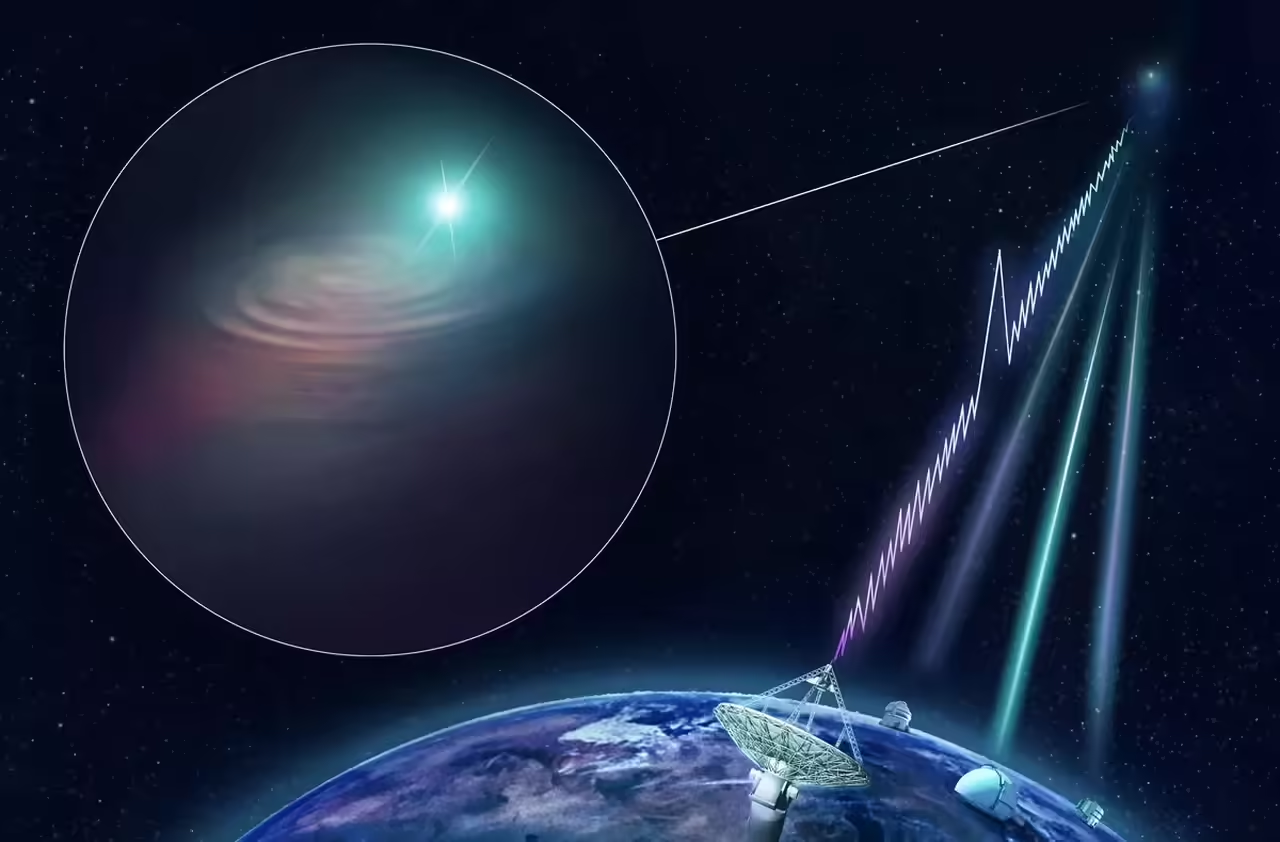
The universe is a vast and mysterious place, and for decades now we have been receiving radio signals from deep space. These enigmatic cosmic transmissions have piqued the curiosity of scientists and enthusiasts alike, raising fascinating questions: Where do these signals come from? What message might they contain? Is there intelligent life beyond our planet?
Cosmic radio signals are electromagnetic pulses that are transmitted through space and reach our planet from very distant regions of the universe. Although most of these signals originate from natural phenomena, such as pulsars or radio galaxies, some have puzzled scientists because of their unusual characteristics and repetitive patterns.
One of the best known cases is that of Fast Radio Bursts (FRBs). These mysterious flashes of energy of short duration and high intensity have been detected sporadically, and their origin has been the subject of debate. Some researchers speculate that they could be generated by neutron stars or even by advanced extraterrestrial civilizations. However, so far no particular theory has been confirmed.
Another intriguing phenomenon is narrowband radio signals. These signals are radio frequency emissions that are transmitted in a narrow band of frequencies and exhibit regular patterns. Some of these signals have been referred to as “WOW! signals” because of the surprise and excitement they generated when they were first detected. Despite efforts to trace their origin, their nature remains unknown.
The search for extraterrestrial intelligence (SETI) has been a scientific discipline that has devoted time and resources to the study of cosmic radio signals in search of possible messages from alien civilizations. Researchers use sophisticated radio telescopes and signal processing algorithms to analyze the transmissions, looking for patterns that suggest intentional communication. So far, no conclusive evidence of signals of extraterrestrial origin has been found.
As technology advances and detection instruments become more sensitive, it is hoped that we will be able to decipher more details about the origin of these signals. In addition, new projects such as the James Webb Space Telescope, which will be launched in the near future, could help shed light on this mystery.
The exploration of radio signals from deep space continues to be an active and exciting field of research. Each new detection brings us one step closer to understanding the nature of our vast universe and to answering one of humanity’s oldest questions: are we alone in the cosmos?
Although we have not yet fully unraveled the mystery of radio signals from deep space, the process of research and discovery continues to advance. Scientists are collaborating around the world, exchanging data and using networks of telescopes to make simultaneous observations and pick up signals more accurately.
In addition, artificial intelligence and machine learning projects are being developed to analyze large amounts of data for meaningful patterns and signals. These advanced techniques could help us identify signals that might otherwise go undetected and discern between natural emissions and those that could be the product of extraterrestrial intelligence.
As the mysteries of cosmic radio signals are unraveled, new questions also arise. What significance might these signals have for humankind? Could they contain valuable information about the composition of the universe, astrophysical phenomena, or even cultural messages from other civilizations?
Regardless of their ultimate origin, radio signals from deep space remain a fascinating field of study that stirs our imagination and drives us to explore the limits of our knowledge. By deciphering their mystery, we may gain a better understanding of our place in the universe and our possible relationship with other life forms.
Alien contact? Analyzing radio signals from distant space
The concept of extraterrestrial life has captivated the human imagination for centuries. The possibility of establishing contact with advanced civilizations beyond our planet has been a source of speculation and debate in the scientific community and society at large. One of the most promising avenues for searching for evidence of intelligent life in the cosmos is the analysis of radio signals from distant space.
Cosmic radio signals have been the subject of study and fascination since they were first discovered. Radio telescopes have played a crucial role in detecting and analyzing these signals, which reach us from remote parts of the universe. Scientists have developed sophisticated algorithms and signal processing techniques to examine and search for patterns in this massive data.
Despite technological advances and efforts devoted to the search for extraterrestrial radio signals, so far no conclusive evidence of contact with alien intelligence has been found. Most of the detected signals are attributed to natural sources, such as pulsars, radio galaxies or astrophysical phenomena not yet fully understood.
However, each detection of an intriguing signal raises new questions and raises hope for a possible encounter with extraterrestrial civilizations. Scientists continue to improve methods of detecting and analyzing radio signals, exploring different frequencies and innovative techniques to increase the chances of finding evidence of intelligent life in the cosmos.
It is important to keep an open mind and approach the subject of alien contact with caution and scientific rigor. The analysis of radio signals from distant space is a complex and challenging undertaking that requires meticulous and thorough research to avoid hasty conclusions or misinterpretations.
As we continue to explore and analyze radio signals from outer space, we must keep an open and scientific mind, ready to face whatever results the investigation reveals. The enigma of alien contact remains an exciting challenge that invites us to explore the limits of knowledge and expand our understanding of the universe.
As technology advances and our detection methods are refined, we are better equipped than ever to investigate and analyze cosmic radio signals for possible signs of extraterrestrial life.
Exploration of distant space and analysis of radio signals also allows us to investigate the diversity of planetary systems and better understand how civilizations form and evolve in the universe. Each new detection and each advance in our understanding brings us closer to answering one of humanity’s most fundamental questions: Are we alone in the universe?
As we move forward in our search for and analysis of radio signals from distant space, it is essential that we maintain a rigorous scientific approach and avoid indulging in sensationalism or unfounded speculation. Research in this field requires global collaboration, with scientists from different disciplines working together to interpret the data and explore all possibilities.
Ultimately, the exploration of cosmic radio signals invites us to question and expand our understanding of the existence and potential of the universe. Whether we succeed in deciphering the enigma of extraterrestrial radio signals or not, the process of searching and analyzing them helps us expand our scientific horizons and appreciate the vast diversity and beauty of the cosmos we inhabit.
Radio Astronomy: The Study of Mysterious Deep Space Signals
Astronomy is a science that has evolved over the centuries, allowing us to explore and understand the vast universe around us. In this quest for knowledge, astronomers have used various techniques to observe space, and one of the most fascinating is Radio Astronomy. Through the detection and analysis of radio waves coming from space, this discipline reveals a unique and exciting perspective of the cosmos. In this article, we will explore what Radio Astronomy is, how it works and some of the fascinating revelations it has offered.
The universe in radio waves:
The electromagnetic spectrum is a wide range of radiation that includes everything from radio waves to gamma rays. Radio Astronomy focuses on the radio wave portion of the electromagnetic spectrum. Although these waves are invisible to our eyes, they can be detected and studied with the help of powerful radio telescopes.
Radio telescopes and how they work:
Radio telescopes are instruments specifically designed to pick up radio waves coming from space. Unlike conventional optical telescopes, which use lenses and mirrors to focus visible light, radio telescopes have antennas that collect the radio waves and direct them to a receiver. This receiver converts the radio signals into electrical signals that can be analyzed and processed by astronomers.
Once the radio signals are picked up, an amplification and filtering process is carried out to remove any unwanted interference. The data is then analyzed using advanced signal processing techniques and transformed into images and spectra that reveal the information contained in the radio waves.
Amazing revelations:
Radio Astronomy has led to revolutionary discoveries in our knowledge of the universe. By observing the cosmos at radio wavelengths, astronomers have uncovered extraordinary cosmic phenomena, such as supermassive black holes at the center of galaxies, explosions of stars called supernovae, molecular clouds where new stars and planets are born, and the cosmic background radiation, a relic of the Big Bang.
In addition, Radio Astronomy has also made it possible to study transient and energetic phenomena, such as fast radio bursts (FRBs), which are intense flashes of radio radiation of unknown origin and extremely short duration. These mysterious events are providing clues about extreme environments and cosmic sources that we do not yet fully understand.
International collaboration and large projects:
Radio Astronomy is a global discipline that involves scientists from different countries working together on ambitious projects. A prime example of international collaboration is the Event Horizon Telescope (EHT) project, which in 2019 succeeded in capturing the first image of a black hole at the center of the Messier 87 galaxy. This monumental achievement was made possible by a worldwide network of interconnected radio telescopes operating as a single high-resolution virtual telescope.
Another outstanding project is the Square Kilometer Array (SKA), a future radio telescope that will be the largest and most sensitive in the world. It is designed to explore the universe at radio wavelengths with unprecedented precision. With facilities in Australia and South Africa, the SKA will enable research in diverse fields of astronomy, from the search for extraterrestrial life to the study of dark matter and dark energy.
Radio Astronomy and its applications:
In addition to its impact on the understanding of the universe, Radio Astronomy has also had practical applications in other fields of science. For example, techniques and technologies developed for the detection and analysis of radio waves have been used in medicine for magnetic resonance imaging (MRI) and in communications for the development of wireless technologies.







